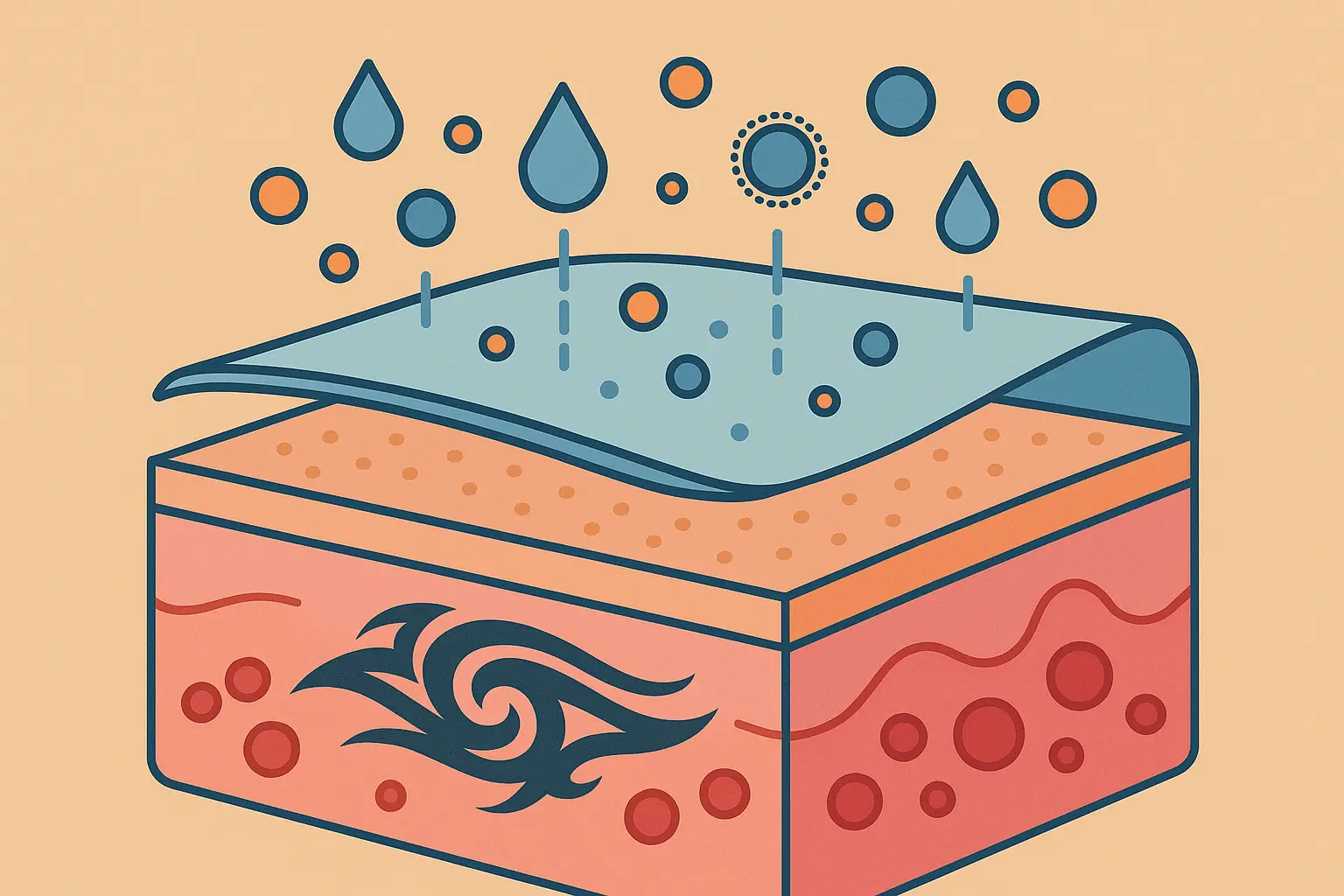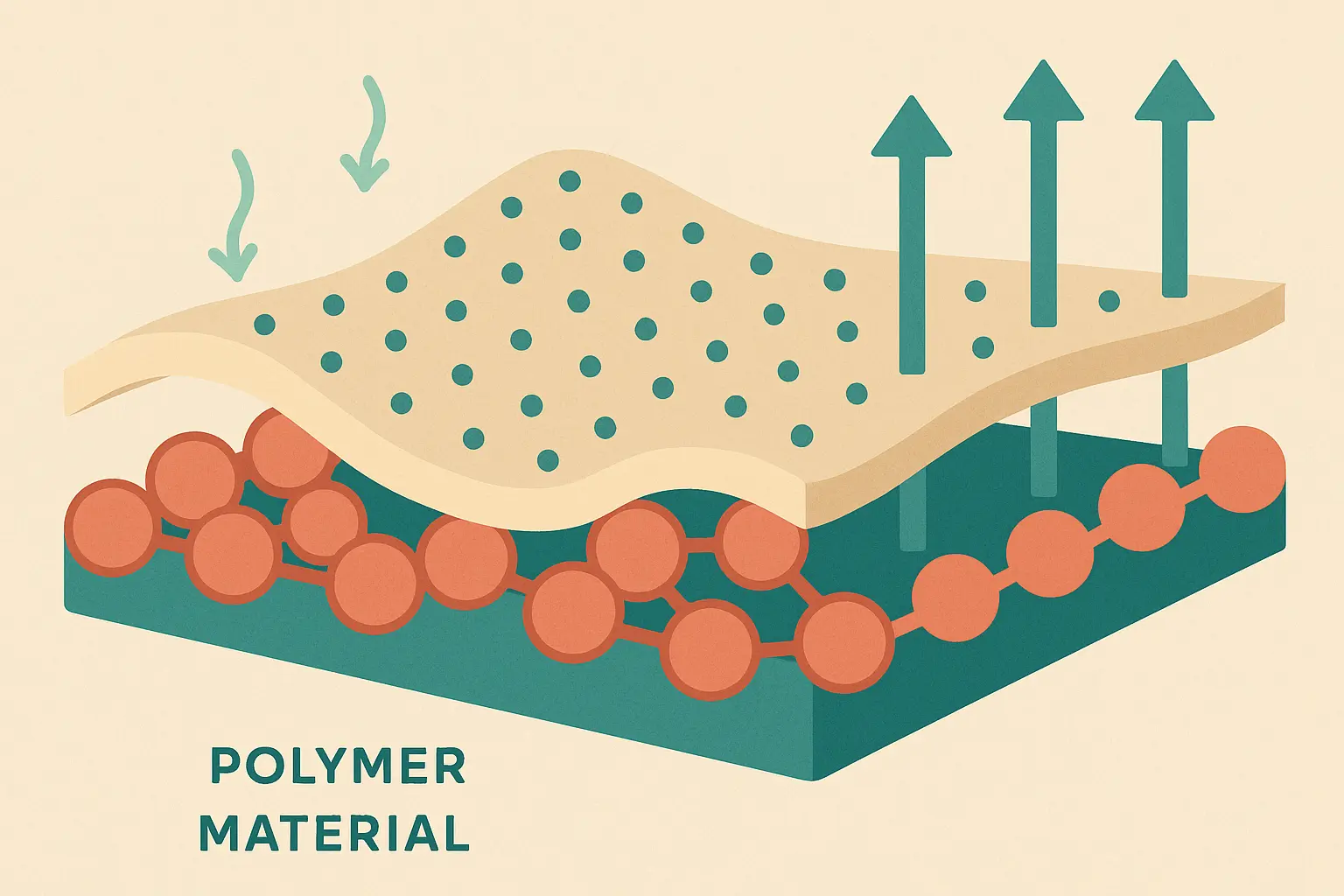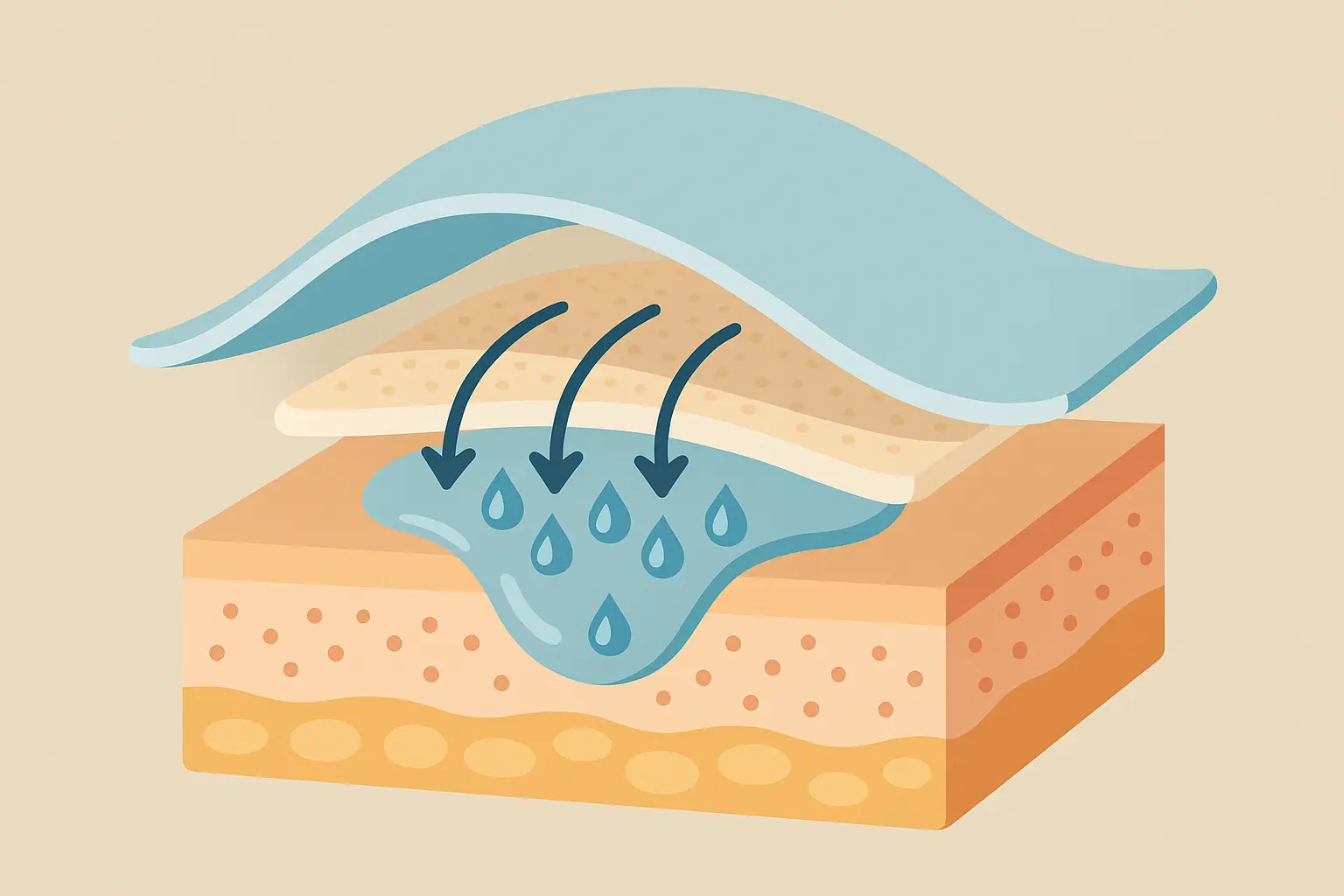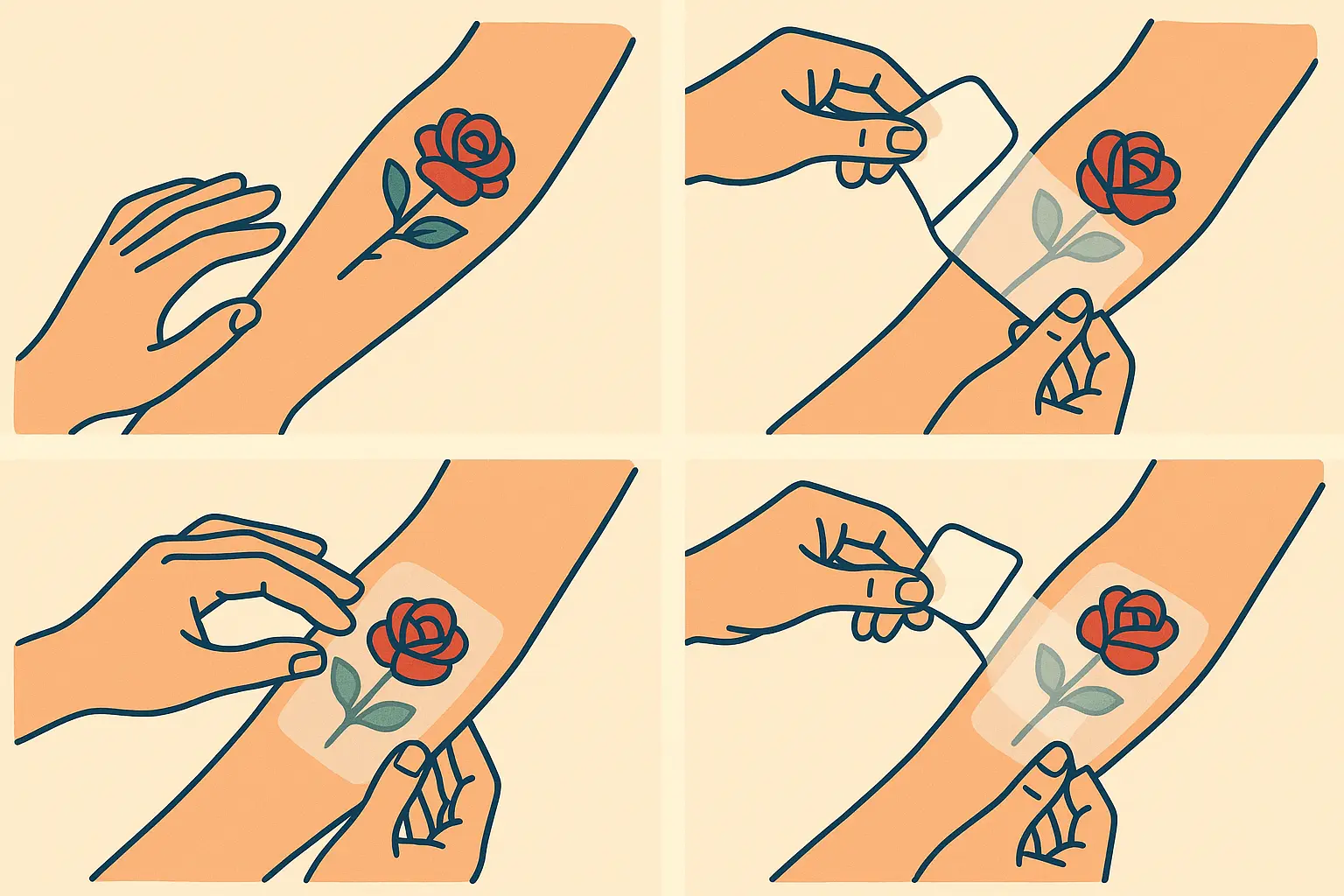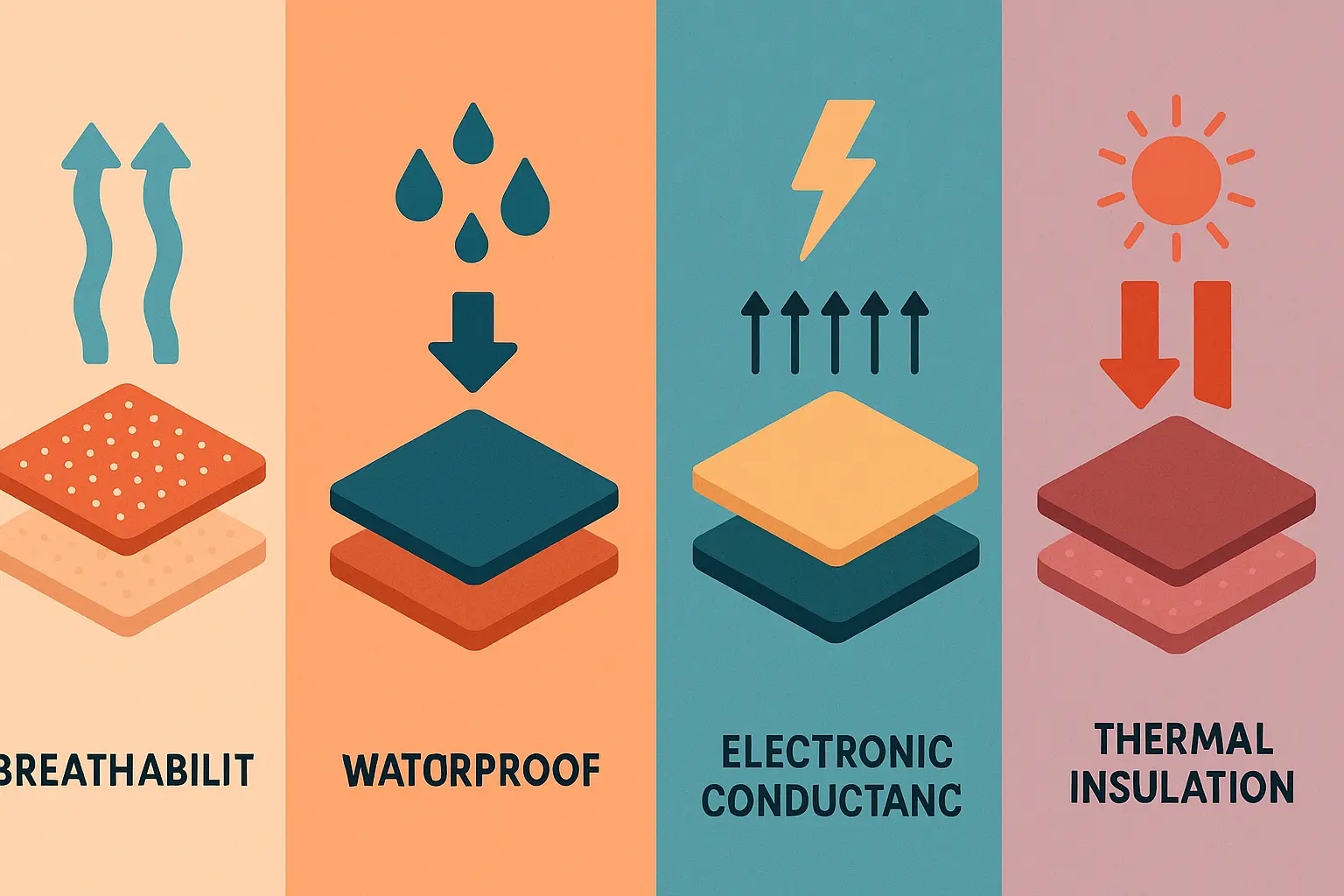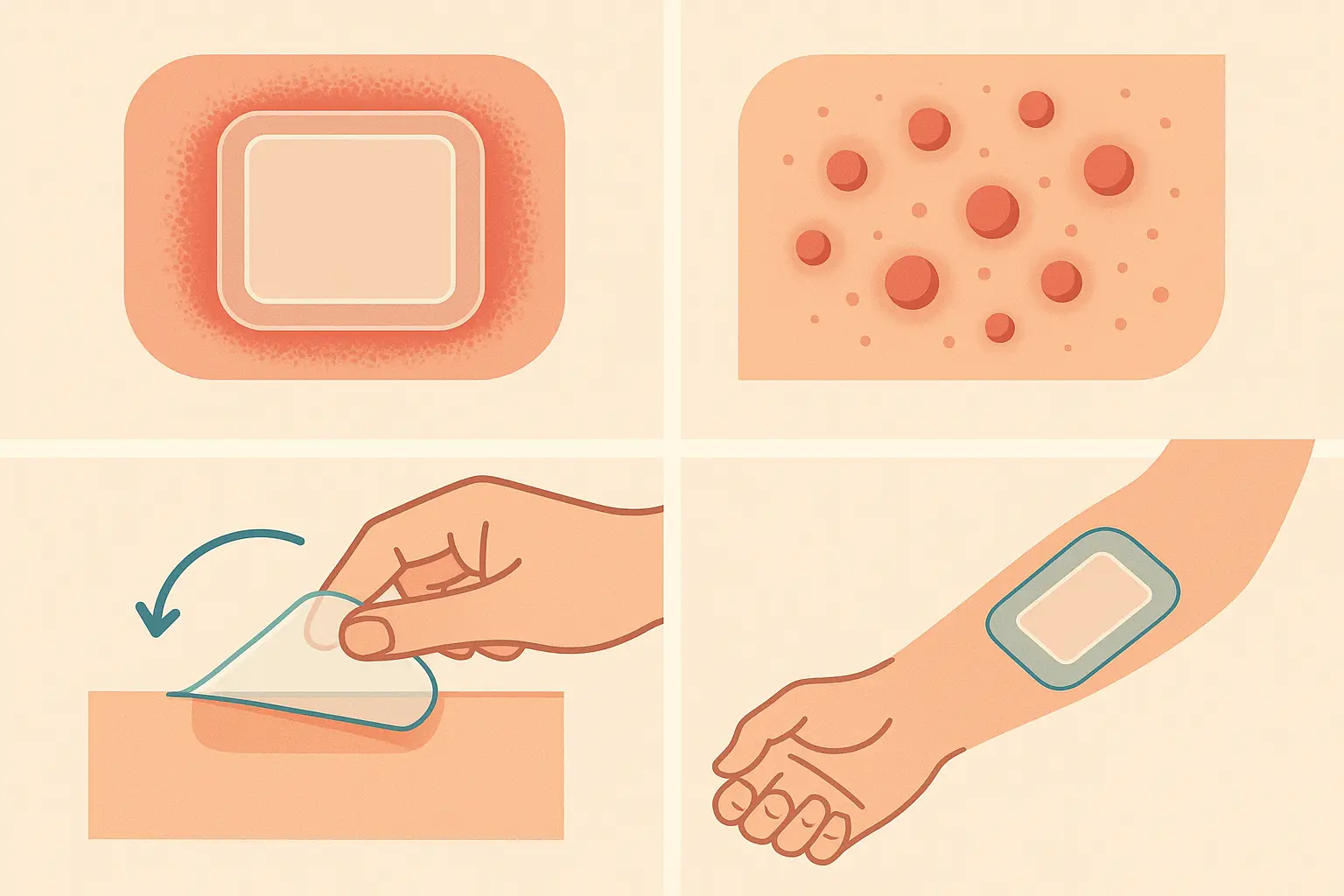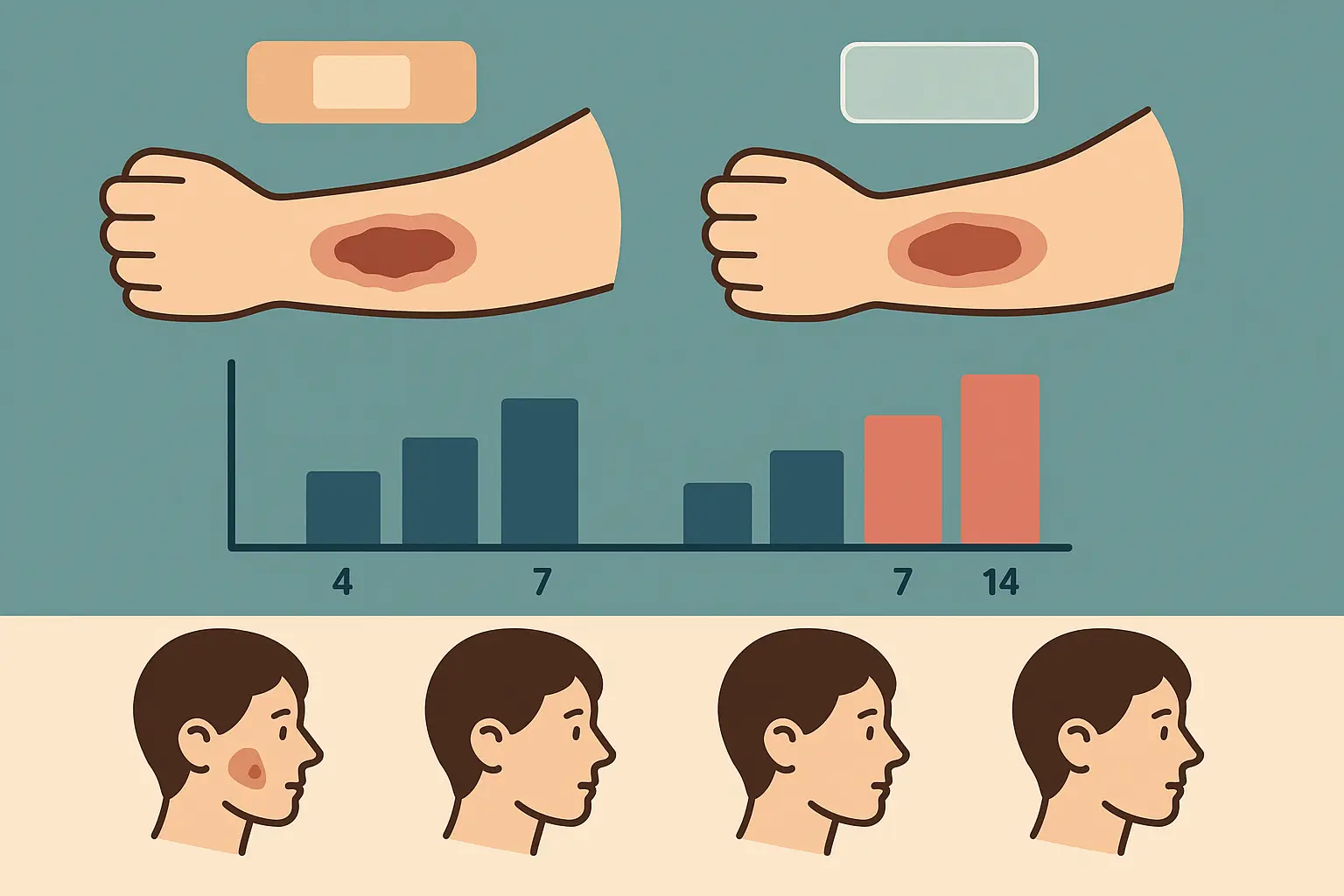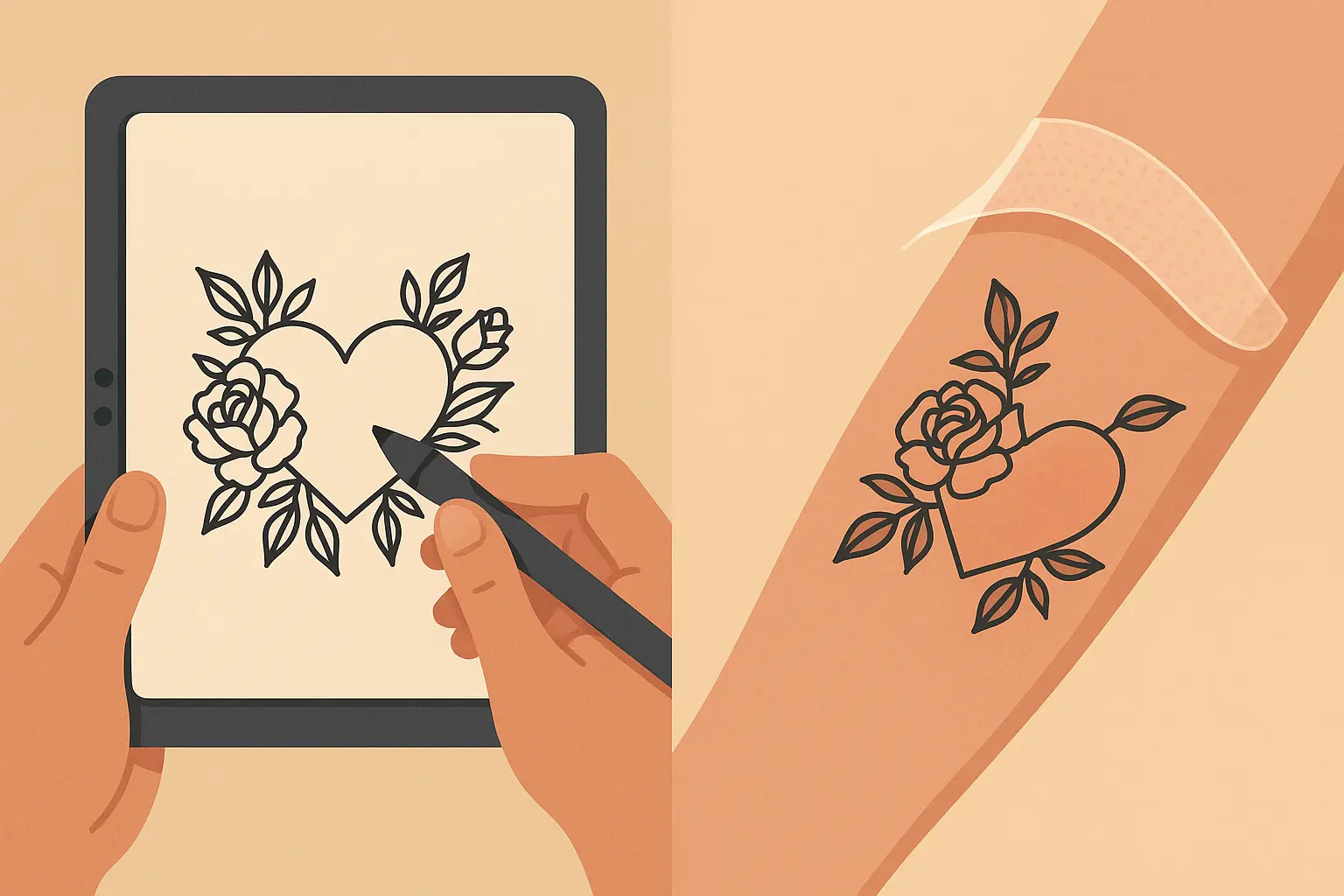Tattoo Second Skin Technology Exposed: What Your Artist Won’t Tell You About Advanced Aftercare
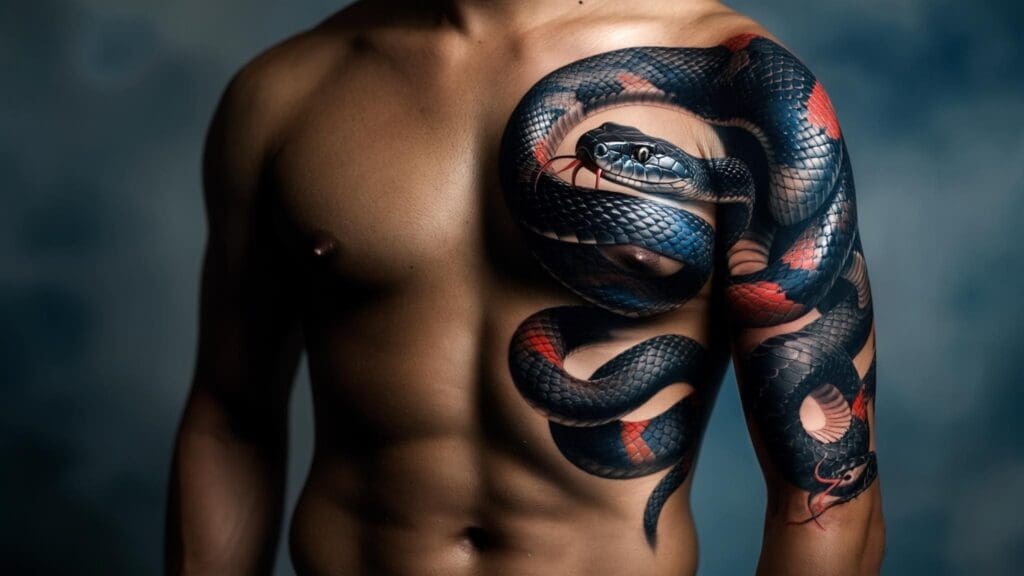
Modern tattoo aftercare has evolved way beyond slapping on some plastic wrap and hoping for the best. With 3-5 days being the sweet spot for second skin protection during those make-or-break healing days, understanding this stuff becomes pretty important if you want your tattoo investment to actually pay off. Here’s what most people don’t realize: we’re dealing with some seriously cool science here that can make or break how your tattoo heals, how the colors hold up, and how it looks years down the road.
I’ve been diving deep into this stuff for years, and honestly, the science behind tattoo second skin blew my mind when I first started researching it. We’re talking about real molecular engineering here, not just some fancy marketing nonsense.
Table of Contents
-
The Real Science Behind Modern Second Skin Technology
-
How Long Should You Actually Keep Second Skin On?
-
Professional Application Secrets Most People Get Wrong
-
Advanced Materials That Change Everything
-
When Things Go Wrong: Troubleshooting Like a Pro
-
Clinical Data That’ll Shock You
-
Future Tech That’s Coming Soon
-
How Tattoo Generator IQ Fits Into Your Healing Journey
TL;DR
-
Modern tattoo second skin uses some pretty cool polymer engineering – it’s definitely not just fancy plastic wrap
-
You’ll want to keep it on for 24-72 hours initially, with some advanced versions lasting up to 7 days
-
Proper application involves specific prep steps that most people totally skip
-
Studies show 30-40% faster healing and way better color retention compared to old-school aftercare
-
Smart versions with hydrocolloid and antimicrobial features actually adapt to your healing
-
Common problems like skin reactions and fluid buildup have specific fixes when you know what to do
-
Future tech includes sensor monitoring and controlled drug release (seriously cool stuff)
The reality is that most people treat second skin as an afterthought, but understanding how this technology actually works can literally make or break how your tattoo turns out.
The Real Science Behind Modern Second Skin Technology
Look, I know this sounds super technical, but basically these aren’t just fancy Band-Aids. Let me break down the cool science that makes modern second skin actually work. We’re talking about engineered materials that act like a smart version of your natural skin – they let the good stuff through while keeping the bad stuff out.
The magic happens because these polyurethane films are calibrated to allow oxygen and water vapor through while blocking bacteria and all the nasty stuff that wants to mess with your healing tattoo. These aren’t random specifications either – the vapor transmission rates (300-800 g/m²/24hr) are carefully calculated so your tattoo gets exactly what it needs to heal properly.
Why This Science Stuff Actually Matters to Your Tattoo
Your skin needs to breathe while it’s healing, but it also needs protection from all the gross stuff in the environment. Think of second skin like a really smart bouncer for your tattoo – it lets oxygen through (oxygen transmission rates of 800-1200 cc/m²/24hr) to prevent nasty anaerobic bacteria from setting up shop, which can cause serious infections in fresh tattoos.
Getting the moisture level right is huge. Too wet and you’re basically creating a bacteria party under there. Too dry and you get those thick, crusty scabs that can rip out your fresh ink when they fall off. Nobody wants that. The controlled 300-800 g/m²/24hr rate keeps things in that sweet spot where your tattoo stays properly hydrated without turning into a bacterial playground.
|
What It Does |
Regular Bandage |
Modern Second Skin |
Why It Matters |
|---|---|---|---|
|
Lets Oxygen Through |
Barely/Not at all |
800-1200 cc/m²/24hr |
Prevents nasty bacteria growth |
|
Controls Moisture |
Hit or miss |
300-800 g/m²/24hr |
Keeps things just right |
|
Blocks Bacteria |
Not really |
99.9% effective |
Way less chance of infection |
|
Moves With You |
Nope |
Stretches 300% |
Actually comfortable to wear |
|
How Long It Lasts |
1-2 days max |
3-7 days safely |
Extended protection |
The Adhesive Chemistry You Never Knew Existed
Those advanced adhesives aren’t just super sticky tape – they use special formulations that bond with your skin without damaging the healing tissue. It’s way more complex than most people realize, but here’s what matters: they create a seal that moves with your skin instead of fighting against it.
The adhesive includes skin-friendly compounds that temporarily bond with your skin proteins. When you’re ready to remove the second skin, these bonds release cleanly without tearing up your delicate new tissue. Pretty cool, right?
Creating the Perfect Healing Environment
Second skin technology controls temperature, humidity, and pH levels specifically for tattoo healing. This controlled environment speeds up healing while preventing scab formation. Why does this matter more than you think? Because scabs can trap ink particles and create uneven healing that affects how your tattoo looks permanently.
Understanding this healing environment becomes even more important when you consider advanced tattoo aftercare techniques that work together with second skin protection throughout your recovery.
Picture this: you get a large shoulder piece. Without second skin protection, thick scabs form within 48 hours, potentially trapping ink and creating patchy healing. With proper second skin application, the controlled environment prevents scab formation entirely, letting your ink settle evenly while new skin grows underneath the protective barrier.
How It Actually Reduces Inflammation
The controlled environment doesn’t just protect – it actively helps reduce inflammation while promoting the good healing factors. This creates conditions where your tattoo ink settles more evenly and healing happens with way less color loss.
Temperature control prevents the excessive heat that can increase inflammation and cause ink to migrate to places you don’t want it. The stable environment also reduces the inflammatory cascade that usually happens when wounds get exposed to environmental irritants and temperature changes.
How Long Should You Actually Keep Second Skin On?
Timing isn’t guesswork – it’s based on how wounds heal, how ink settles, and how your specific skin responds. I’m going to give you the real timeline that considers tattoo size, where it’s located, and environmental factors, because that generic “leave it on for 3 days” advice you usually hear is way too simple.
The truth is, how long to keep second skin on tattoo depends on multiple factors that most people never think about. Your skin type, where the tattoo is located, what you’re doing while it heals, and even the weather all play a role in the optimal wear time.
The Critical First 72 Hours
Those first 24-72 hours are make-or-break time for your tattoo. My tattoo artist Sarah always tells her clients the same thing: “Those first few days are make-or-break time.” I learned this the hard way with my first tattoo – pulled off the second skin after just one day because I was paranoid about that fluid buildup. Big mistake. The scabs that formed pulled out half my line work.
According to professional tattoo aftercare protocols, “Keep Second Skin on for 3–5 days—long enough to protect your tattoo during the most critical healing stage” (The Ruby Gore Tattoo Aftercare Guide). But here’s what they don’t tell you: this timeline can vary big time based on how your body heals.
During these first 72 hours, your tattoo is basically an open wound. The second skin creates a sterile bubble that prevents contamination while your skin starts healing. Take it off too early, and you’re exposing vulnerable tissue to bacteria and environmental damage. Leave it too long, and you might get adhesive reactions or too much fluid buildup.
Managing All That Gross Fluid Buildup
Let’s address the elephant in the room – that nasty-looking fluid that builds up under your second skin. I know it looks like something from a horror movie, but it’s actually a good sign that your body is doing its job. This plasma and lymphatic fluid is normal – it’s managed through controlled absorption and evaporation that prevents the soggy environment that can cause ink migration or color problems.
Professional guidelines say that “excessive fluid buildup (more than a soy sauce packet amount)” means it’s time to replace the bandage (The Ruby Gore Tattoo Aftercare Guide). I know that sounds gross, but this fluid is actually part of your body’s natural healing response. The key is managing it properly without freaking out.
Extended Wear: When a Week Makes Sense
Modern versions can stay on up to seven days, but this isn’t right for everyone. Extended wear gives you continuous protection benefits, but you need to watch for skin irritation, adhesive reactions, or excessive fluid that signals it’s time for early removal.
How long to leave second skin on tattoo for extended periods depends on the specific product you’re using and how your skin responds. Some people can comfortably wear advanced versions for a full week, while others need to remove them after 3-4 days to prevent complications.
Extended wear periods work well with understanding the natural peeling process that happens beneath the protective barrier during healing.
Why Longer Protection Equals Better Color
There’s actual proof that longer protection periods lead to better color retention and sharper line definition. The controlled environment prevents premature scabbing that can pull out fresh ink deposits – something most people don’t realize until it’s too late and they’re looking at a patchy tattoo.
When you know how long to keep second skin on properly, you’re basically giving your tattoo the best possible chance to heal with maximum color vibrancy and line clarity. The extended protection lets ink particles settle into the right spots without interference from scab formation or environmental contamination.
Professional Application Secrets Most People Get Wrong
Proper second skin application isn’t as simple as peel-and-stick, and most people mess up the basics. I’ll share the pro-level techniques for skin prep, getting good adhesion, and removal strategies that maximize healing benefits while avoiding complications that could mess up your tattoo.
Most people think applying second skin tattoo protection is as easy as peeling off the backing and slapping it on. Wrong. Professional application requires specific techniques that ensure it actually sticks, prevents problems, and maximizes healing benefits. The difference between amateur and pro application can literally make or break your tattoo’s healing process.
Skin Prep That Actually Works
Good application starts way before you touch that backing paper. Thorough skin cleaning, dealing with hair, and getting proper skin temperature and dryness for optimal sticking are steps most people completely skip.
Your Pre-Application Checklist:
-
Clean the tattooed area with antibacterial soap
-
Make sure it’s completely dry (wait 5-10 minutes)
-
Remove any hair around the tattoo edges
-
Check skin temperature (should be room temp, not hot from the shower)
-
Make sure no lotions or oils are left on the skin
-
Have clean hands and a clean workspace ready
The skin prep phase determines whether your second skin will stay put for the full healing period or start peeling off within hours. I’ve seen too many people skip these steps and wonder why their expensive second skin fails after one day.
Creating a Clean Work Area
Professional application includes specific cleaning that eliminates surface bacteria without messing with your skin or the adhesive performance. You want to eliminate bacteria without over-drying the skin or leaving chemical residues that prevent proper sticking.
You’re looking to kill bacteria without creating conditions that interfere with adhesion. This balance requires specific products and techniques that most people never learn about.
Installation Techniques That Prevent Problems
Getting the right size, eliminating bubbles, and sealing edges aren’t perfectionist details – they make sure you get complete coverage without restricting blood flow or creating pressure points. The step-by-step process pros use makes the difference between successful healing and complications.
A professional tattoo artist applying second skin to a forearm piece will cut the bandage 2 inches larger than the tattoo perimeter, apply from center outward to eliminate air bubbles, then use overlapping strips for larger pieces rather than trying to cover everything with one massive piece that creates tension points.
Getting rid of bubbles requires working from the center outward with firm, consistent pressure. Any air bubbles left under the second skin create weak spots where bacteria can get in or where the adhesive will fail early.
Edge Sealing and Tension Management Secrets
Creating solid edge seals prevents bacterial infiltration while maintaining flexibility for natural skin movement. You need to account for how your skin stretches and moves while avoiding over-tension that causes premature lifting or circulation problems.
Edge sealing involves creating overlapping borders that move with your skin rather than fighting against it. Managing tension requires understanding how your skin moves in different positions and activities, then applying the second skin with appropriate stretch to handle this movement.
Safe Removal Without Destroying Your Healing
Removal technique can make or break your healing process. Using the right methods to soften adhesive, gradual peeling techniques, and post-removal skin care prevent damage to newly healed tissue – because ripping it off wrong can undo weeks of healing.
Professional removal emphasizes that you should ” remove it slowly. Removing second skin can be painful, especially when it’s been there for a while” (Piranha Tattoo). This isn’t just about comfort – aggressive removal can damage the delicate new skin that’s formed underneath.
The removal process should take several minutes, not seconds. You’re working with tissue that’s been protected and may be more sensitive than normal skin. Rushing this process can cause tearing, bleeding, or damage to the newly formed skin layers.
Advanced Materials That Change Everything
We’ve moved way beyond basic films. I’ll explore cutting-edge hydrocolloid matrices, silicone-based membranes, and materials that actually adapt to your individual healing patterns and skin chemistry – technology most people don’t even know exists.
The evolution of second skin for tattoos has picked up serious speed in recent years. We’re seeing materials that actually participate in the healing process rather than just providing protection. These advanced formulations represent real breakthroughs in wound care technology applied specifically to tattoo healing.
Hydrocolloid Integration That Actually Thinks
Hydrocolloid-enhanced second skins contain gel-forming agents that absorb excess wound fluid while maintaining optimal moisture levels. These create dynamic healing environments that automatically adjust to changing wound conditions.
The hydrocolloid technology works by forming a gel when it contacts wound fluid. This gel creates a moist healing environment that promotes faster cell regeneration while absorbing excess fluid that could cause complications. The system basically self-regulates based on your tattoo’s specific healing needs.
Smart Absorption That Adapts to You
These systems detect fluid levels and modify their absorption accordingly. This prevents both dehydration and oversaturation that could mess with ink stability or healing quality – it’s basically intelligent bandage technology.
The smart absorption happens through polymer chains that expand and contract based on fluid levels. When your tattoo produces more fluid, the material absorbs more. When fluid production decreases, the material releases stored moisture to maintain optimal healing conditions.
Bio-Compatible Materials That Bond With Your Skin
Advanced formulations use materials that chemically bond with skin proteins temporarily, creating seamless barriers that move naturally with your skin. This maintains protective integrity throughout healing while feeling almost invisible.
The growing focus on skin preservation has reached new extremes, with companies like “Save My Ink Forever” now preserving tattooed skin after death, highlighting just how valuable proper tattoo care and preservation has become in modern culture (Popular Science). This trend shows why using the best possible materials during healing makes total sense.
Bio-compatible bonding creates a temporary fusion between the second skin tattoo cover and your natural skin. This eliminates the interface where bacteria typically get into traditional bandages. The bond is strong enough to maintain protection but designed to release cleanly when removal time comes.
Active Antimicrobial Protection Systems
Modern second skins incorporate silver nanoparticles, iodine complexes, or natural antimicrobial compounds for active infection prevention rather than just passive barrier protection. These work by continuously releasing antimicrobial agents that eliminate bacteria before they can establish infections.
Silver nanoparticles are particularly effective because they provide broad-spectrum antimicrobial activity without developing resistance. The nanoparticles are embedded in the second skin material and release slowly over the wear period, maintaining sterile conditions throughout healing.
|
Material Type |
Active Ingredients |
Protection Duration |
Best For |
Cost Factor |
|---|---|---|---|---|
|
Standard Polyurethane |
None |
3-5 days |
Basic protection |
$ |
|
Hydrocolloid Enhanced |
Gel-forming agents |
5-7 days |
High fluid tattoos |
$$ |
|
Silver-Infused |
Silver nanoparticles |
7 days |
Infection-prone areas |
$$$ |
|
Silicone Matrix |
Medical-grade silicone |
3-7 days |
Sensitive skin |
$$ |
|
Bio-Responsive |
pH-sensitive polymers |
Variable |
Custom healing |
$$$ |
When Things Go Wrong: Troubleshooting Like a Pro
Okay, let’s talk about when things go sideways – because they will, and it’s not your fault. Even with perfect application, complications can happen. Your skin might freak out unexpectedly, environmental factors could mess things up, or the material itself might not perform as expected. Having troubleshooting strategies ready means you can address problems quickly before they turn into serious issues.
Dealing With Adhesive Reactions
If your skin starts looking like an angry tomato around the edges of your second skin, don’t tough it out. I’ve seen people try to “power through” allergic reactions, and it never ends well. Your tattoo will be fine if you remove the bandage early – it won’t be fine if you end up with a chemical burn around it.
Adhesive reactions typically show up as redness, itching, or burning sensations around the bandage edges. These reactions can develop within hours or after several days of wear. The key is recognizing early warning signs and acting fast.
Alternative Strategies for Sensitive Skin
For people with sensitive skin, modified application techniques including reduced adhesive contact, shorter wear periods, or alternative materials can maintain protection benefits while accommodating skin sensitivities. The workarounds that actually work involve barrier creams, hypoallergenic formulations, or segmented application methods.
Sensitive skin doesn’t mean you can’t use second skin tattoo aftercare effectively. It means you need to modify your approach. Some people apply a thin layer of barrier cream around the tattoo perimeter before applying the second skin, creating a buffer zone that prevents direct adhesive contact with sensitive areas.
Handling Excessive Fluid Buildup
When too much fluid accumulates under your second skin, strategic perforation or partial removal techniques allow drainage while maintaining protective coverage over critical areas. Here’s exactly how to do this without messing up your healing.
If fluid buildup exceeds the size of a quarter under your second skin, create a small drainage hole using a sterile needle at the lowest point of the bandage, then cover the hole with a small piece of medical tape. This maintains protection while allowing controlled drainage.
Fluid management becomes critical when dealing with larger tattoos or areas that naturally produce more lymphatic drainage. The goal is maintaining protection while preventing the soggy environment that can cause ink migration or bacterial growth.
Pressure Relief and Circulation Fixes
Advanced practitioners use pressure relief cuts or graduated tension application to prevent circulation restriction while maintaining protective seal integrity. These techniques can save your tattoo when things get tight.
Pressure relief involves making strategic cuts in the second skin material that allow expansion without compromising the protective barrier. These cuts are placed in areas where natural skin movement creates tension, allowing the material to flex without pulling away from the tattoo.
Clinical Data That’ll Shock You
The numbers don’t lie – clinical studies show dramatic improvements with proper second skin use. Medical research has finally caught up with what tattoo artists have observed for years: proper second skin tattoo protection dramatically improves healing outcomes. The quantitative data supporting these improvements is compelling enough that many medical professionals now recommend second skin for all tattoo aftercare.
Healing Speed That’ll Blow Your Mind
Controlled studies show accelerated healing rates under second skin protection, with new skin formation occurring 2-3 days faster than exposed healing methods. What this means for your tattoo timeline and final results is significant – you’re looking at reduced downtime and faster return to normal activities.
The accelerated healing occurs because the controlled environment eliminates many factors that slow natural healing processes. Without exposure to environmental contaminants, temperature fluctuations, and mechanical trauma, your skin can focus entirely on regeneration rather than defense.
Infection Rates Drop Dramatically
Medical literature shows infection rates drop from 8-12% with traditional aftercare to less than 2% with proper second skin application. This represents significant safety improvements and what it means for your peace of mind is substantial – you can focus on healing rather than worrying about complications.
The infection prevention happens through multiple mechanisms: bacterial barrier protection, controlled moisture levels, and elimination of contamination sources. Traditional aftercare methods expose healing tattoos to environmental bacteria repeatedly during cleaning and reapplication of ointments.
Color Preservation Data You Need to See
Quantitative analysis reveals 15-25% better color retention in tattoos protected with second skin during initial healing. This is particularly important for fine line work and color gradients, and how it affects your long-term tattoo appearance is dramatic.
Color preservation becomes even more critical when considering high-pain areas where healing complications are more likely to occur without proper protection.
The color retention improvement occurs because second skin prevents scab formation that can trap and remove ink particles during healing. Traditional healing methods often result in thick scabs that pull away ink deposits when they eventually fall off.
Line Definition That Stays Sharp
Second skin protection maintains sharper line definition and prevents ink bleeding that commonly occurs during traditional scab formation and removal processes. The before-and-after data proves this difference is measurable and significant.
With dangerous social media trends promoting “sun tattoos” and unprotected sun exposure causing skin damage, proper tattoo protection becomes even more critical for maintaining skin health and tattoo integrity (Medscape).
Sharp line definition depends on ink particles settling into precise dermal locations without migration or dilution. Second skin technology maintains the exact conditions needed for this precise settling process.
Future Tech That’s Coming Soon
Picture this: in a few years, your tattoo bandage will basically be a tiny computer that texts you updates. “Hey, your healing is on track!” or “Time to change me!” It sounds like science fiction, but we’re almost there. Innovation in tattoo aftercare is accelerating rapidly. Research labs are developing second skin tattoo instructions that will be delivered through smartphone apps connected to smart bandages.
Smart Sensors That Monitor Your Healing
Development of second skin patches with embedded sensors will monitor temperature, pH, moisture levels, and bacterial presence in real-time. Smartphone connectivity will provide healing status updates and what this means for the future of aftercare is revolutionary – you’ll know exactly when to change bandages, when healing is progressing normally, and when complications are developing.
The sensor technology uses biocompatible electronics that can detect chemical changes in wound fluid. These sensors communicate wirelessly with smartphone apps that track healing progress and provide personalized recommendations based on your specific healing patterns.
Controlled Drug Release Systems
Future second skin products will incorporate time-released healing compounds, pain management medications, and color-preservation agents delivered directly to healing tissue. Controlled-release mechanisms will change everything about tattoo recovery by providing targeted therapeutic intervention throughout the healing process.
Drug delivery through second skin eliminates the need for oral medications or topical applications that can interfere with healing. The controlled release ensures therapeutic levels are maintained consistently without the peaks and valleys associated with traditional dosing schedules.
AI-Driven Personalized Aftercare
Integration of healing data with AI systems will enable personalized aftercare recommendations, optimal removal timing, and early complication detection through predictive analytics. This technology will customize healing protocols for each individual tattoo and person.
AI analysis of healing patterns will identify optimal care strategies based on tattoo characteristics, skin type, environmental factors, and individual healing responses. The system will learn from thousands of healing cases to provide increasingly accurate recommendations.
How Tattoo Generator IQ Fits Into Your Healing Journey
When you’ve invested time creating the perfect design through Tattoo Generator IQ’s AI-powered platform, understanding advanced second skin technology becomes crucial for preserving that artistic vision. Our comprehensive tattoo planning approach perfectly complements this aftercare knowledge, helping you protect your investment from digital concept to healed masterpiece.
The placement guides and artist-ready references we provide become even more effective when both you and your artist understand proper healing protocols and timing expectations. Your carefully planned design deserves the best possible healing environment to achieve its full potential.
Whether you’re planning your first tattoo design or considering a complex arm piece, proper second skin aftercare ensures your AI-generated design heals exactly as envisioned.
The connection between design planning and healing success is stronger than most people realize. When you understand both the creative process and the science of healing, you can make informed decisions that protect your artistic investment throughout the entire tattoo journey.
Ready to create your perfect tattoo design? Visit Tattoo Generator IQ to start planning your next piece with our advanced AI technology, then use this tattoo second skin knowledge to ensure it heals beautifully.
Final Thoughts
Look, at the end of the day, this is all about protecting something you’re going to live with forever. I’ve seen too many people spend hundreds or thousands on amazing tattoos, then skimp on $30 worth of proper aftercare. Don’t be that person.
Advanced tattoo second skin technology represents a real breakthrough in aftercare, moving far beyond basic protection to create scientifically optimized healing environments. The molecular engineering, controlled permeability, and smart materials we’ve explored aren’t marketing buzzwords – they’re legitimate innovations that can dramatically improve your tattoo’s healing process and final appearance.
Understanding proper application timing, removal techniques, and troubleshooting methods empowers you to take control of your healing journey rather than hoping for the best. The clinical data showing faster healing times, better color retention, and reduced infection rates proves that investing in quality second skin products and proper technique pays off in measurable ways.
As this technology continues evolving towar
As this technology continues evolving toward smart sensors and personalized healing protocols, staying informed about these advances will help you make better decisions for future tattoos. Your skin deserves the best protection science can offer, and now you have the knowledge to demand it. Your future self will thank you when your tattoo still looks incredible years from now.

